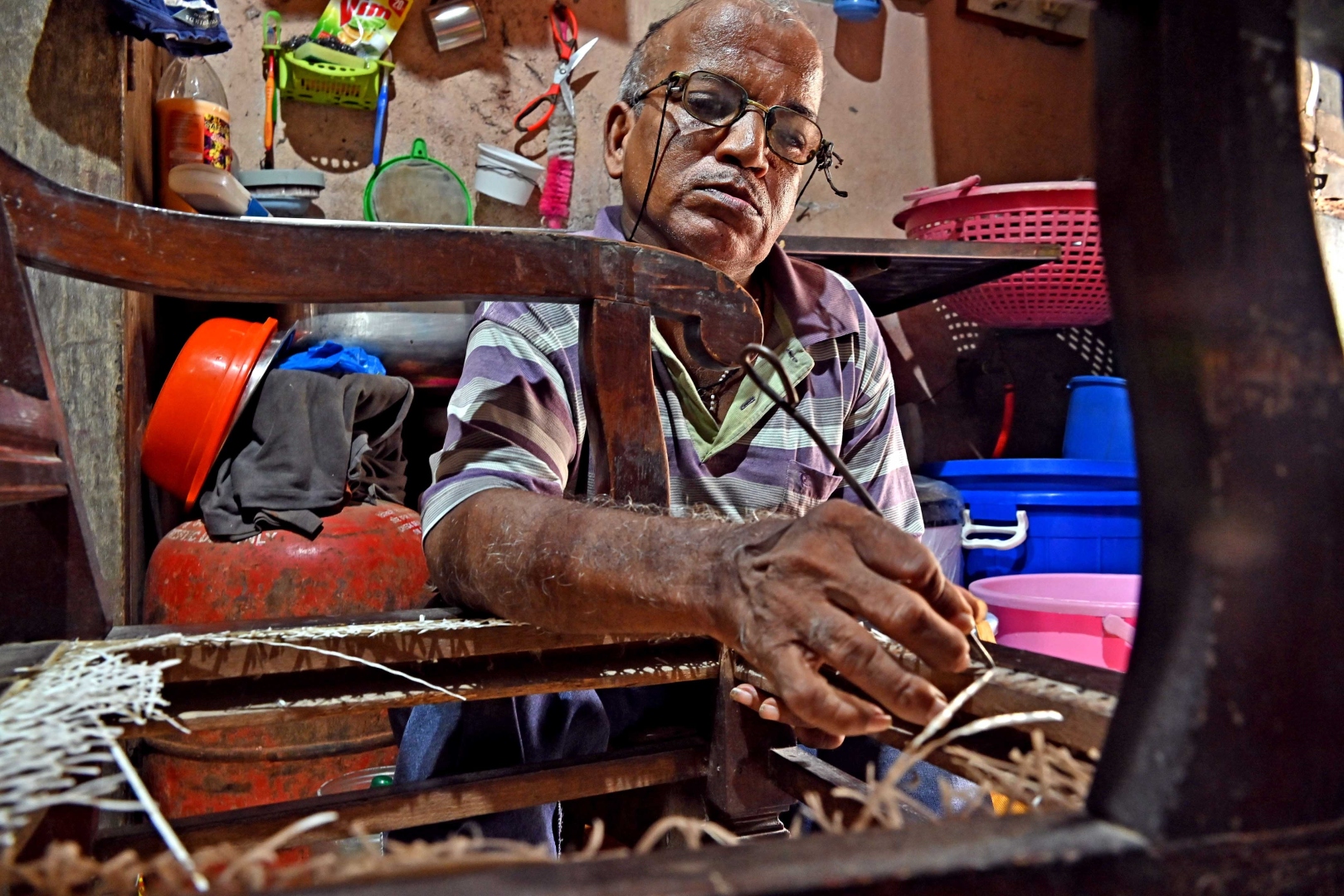Weaving cane chairs since the 1980s, the artistic Santan Rebello is now out of work with the traditional art dying as people no longer use wooden chairs. The Goan speaks to the man with strong hands and a stronger undying spirit to fight back...

To many, Santan Rebello may seem to be a nondescript personality, but those living in Taleigao are well familiar with his artistic skills of weaving cane chairs with much ease. In Goa, this art is called Rotesao. Sadly, this traditional local art of weaving cane strips into the intrinsic holes in the wooden chairs that Goan homes proudly possessed a few decades ago, is now dying. The weaved chairs are no longer in use. Very few Portuguese-styled houses may have them in use, or a well-preserved state. But the government offices that used them widely, have now discarded them and instead, plastic or metal chairs are used. Santan’s skills are no longer used, and he gets very few orders. With this lone skill that he learnt in 1981 and began practising in 1986, Santan is now out of work.
A polio-disabled Santan has short limbs but thankfully, he has strong hands, and much stronger than that he has an undying spirit to fight back. At 50, he and his wife live at Taleigao, all by themselves in a tiny, one-room shed that the duo call their home. It was not difficult to hunt for his hut, yes, it’s almost a hut with unpolished laterite walls and tinned roof, a broken door, and no window. The only instruction that he gave to reach his home is, "Come to Taleigao church, then take the right road that takes you to a hall, look for an electricity office and enter the same lane, my home is at the end of that lane."
As we reached Santan’s house after much help from a good samaritan, we found the door open, and him sitting. Welcoming us, he offered a seat. The room was dingy, with a tube light on, even in the afternoon. The unpainted walls were full of photographs of family, Gods, and Goddesses. This is Santan’s home, where he and his better-half Sophia lives, struggling to make both ends meet. Their bright warm smiles defied their weak financial status. Welcoming ‘The Goan’ into their little world, the duo narrated their story, adding at the end, to mention if anyone in Goa has Rotesao chairs for repair.
A peek into the life of Santan reveals that he learnt the art in the early 1980s and began taking orders in mid-1980. Since then, he has been tirelessly weaving. Instead of cane, he uses plastic strips. The remuneration he is being paid is very low – anything between Rs 250 to 450 per chair.
“If I ask Rs 550, they bargain to pay me Rs 400. I cannot refuse, as nowadays no one uses these chairs so whatever work comes, I accept,” says Santan who recently volunteered at the Purumentachem Fest held at Caculo Mall and conducted live demos and workshops for enthusiastic learners of Rotesao art.
Santan’s disability is his weakness, but his mastery of this art is his strong point. “I wanted to do some job, when I was young, but was not lucky enough to get one. So, I thought of embracing Rotesao art and tried to earn a living out of my skills. I don’t mind working hard even at this age, but there are no repair orders. No new furniture maker thinks of making such chairs. For generations, Goa had this unique culture of having voltairs on the balconies, where the elderly sat in the evenings and chat over chai. These voltairs had Rotesao weaves. The beds too had them. Dining chairs, easy chairs, sofas and even tables had Rotesao. But now, everything is diminishing, the art, the culture and the authentic Goan population,” laments Santan who survives on Rs 2,000 social welfare aid from the government. His wife receives Rs 1,500 under the Griha Aadhar scheme, but the amount does not get deposited in her account every month regularly.
Santan has a four-wheeler scooter which he drives, but that needs fuel too. He accepts orders from nearby places and goes on this scooter to do Rotesao weaving. But he has to be picked and dropped if the client lives far away. He also needs money to purchase the plastic strips for weaving, apart from paying for his grocery.
Overall, life seems to have stopped for them in the middle of a beautiful township like Taleigao where the rich and the famous live.
He shares, “I could walk, even though with great difficulty, few years ago, but now my legs have no strength. But I can still weave chairs and will keep doing that till I live. This skill has fended me for so long, and I am thankful to God for being so kind, so long.”